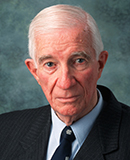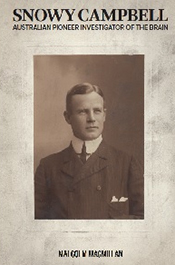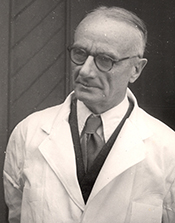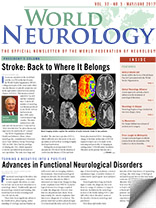By M. J. Eadie

M. J. Eadie
In Northern Hemisphere countries, from about 1860 onward, the specialty of clinical neurology emerged after increasing numbers of medical graduates focused their interests and restricted their clinical practices to the study and management of organic disease of the nervous system. A similar process occurred in Australia, but lagged by some four decades so that the specialty of clinical neurology there became firmly established only by the mid-20th century.
Several factors contributed to the Australian delay. European migration to the country began in 1788. Initially, the migration was composed largely of convict settlements, with free settlers beginning to arrive a few decades later. The Australian population sites that developed were far from Northern Hemisphere cities and educational institutions and also were considerable distances from each other. The individual sites needed to become large enough before specialist medical practice was feasible in them.
In the latter third of the 19th century, accounts of neurological disorders peculiar to Australia began to emerge. For example, children were being diagnosed with lead poisoning, and those who ate finger cherry fruit experienced acute bilateral visual failure. There were reports of disorders, such as leprosy, beriberi neuritis, and tick bite paralysis, not often seen in temperate climates. With few exceptions, Australian authors did not publish again on the same topic.
However, in the 1880s in Melbourne, John William Springthorpe became interested in epilepsy, and in the 1890s, S. Jamieson wrote on both syphilis and peripheral neuritis.
George Edward Rennie
The first man to take a major continuing interest in clinical neurology in Australia was George Edward Rennie (1861-1923). Originally from Sydney, he received his medical education (MB and MD) at the University College London and returned to Sydney. By 1898, Dr. Rennie became an honorary physician to the Royal Prince Alfred Hospital. He resigned that appointment and returned to London. He took the membership of the Royal College of Physicians, returned to Sydney in 1900, and re-ascended the honorary consultant ladder at his hospital to become its senior physician (from 1912 to 1921).
Dr. Rennie seems not to have carried out any significant original research, but wrote on neurological topics, such as the functional anatomy of the cerebellum, meralgia paraesthetica, the physiology of voluntary movement, the curability of epilepsy, the treatment of peripheral nerve diseases, the effects of spinal cord transection, and the possibility that occupation and peripheral trauma might determine the site of syphilitic cerebral pathology. He provided the neurological input to the main teaching hospital of Australia’s largest city but, with writings on topics such as pneumonia, tuberculosis, pernicious anemia, childhood deafness, and endocrine topics, he never restricted his activities to clinical neurology.
Alfred Walter Campbell

Alfred Walter Campbell
Alfred Walter Campbell (1868-1937) was the first person in Australia to practice purely as a clinical neurologist. He was born on a pastoral property in southern New South Wales, educated locally, and, at the age of 18, traveled to Edinburgh, Scotland, for medical studies. He graduated with an MB CM in 1889.
After short-term appointments in British psychiatric institutions and some months in Vienna with Richard von Krafft-Ebing, he spent a year at the State Asylum in Prague, where his histological research on “alcoholic neuritis” brought him an Edinburgh MD degree in 1892. He then became medical officer and resident pathologist at the Lancaster County Asylum (Rainhill), near Liverpool, where he spent the next 13 years publishing a considerable amount of neuropathological investigation into various topics, such as the degeneration of spinal tracts connected to the cerebellum. He was the sole author of all of this work, except for a lengthy account of the pathology of herpes zoster, co-authored with (the subsequently Sir) Henry Head. Head supplied the clinical data to correlate with Dr. Campbell’s histological findings in the nervous systems of 21 zoster sufferers. A map of the distribution of the human dermatomes resulted. Dr. Head’s role in this great achievement is still remembered, while Dr. Campbell’s is forgotten.
From about 1900 on, Dr. Campbell systematically investigated the histology of the entire normal human cerebral cortex, as a preliminary to searching for histological changes in the cortex that might correlate with mental illness, something that macroscopic pathology had failed to do. He studied serial sections from tissue blocks from 50 to 60 gyri per hemisphere in five hemispheres, staining alternate sections for myelinated nerve fibers and neuronal cell bodies, and in a further three hemispheres for nerve fibers only. He also sought retrograde cortical histological changes where altered brain function resulted from lesions below the cortex. He identified 12 histologically distinct areas in the cerebral cortex.
The future Nobel Laureate C.S. Sherrington, then professor of physiology in nearby Liverpool, read the findings on Dr. Campbell’s behalf to the Royal Society of London (1903 and 1904). The abstracts appeared in the society’s Philosophical Transactions, but the full paper was too extensive for publication. The society regarded the work highly enough to subsidize its publication by Cambridge University Press as Histological Studies on the Localization of Cerebral Function. The monograph appeared in late 1905, some three years before Korbinian Brodmann’s similar investigation was published.
Before his monograph was in print, Dr. Campbell returned to Australia, never leaving his homeland again except to serve with the Australian Army Medical Corps in Egypt during World War I. One factor in his abandoning his British career at his moment of triumph probably was his 1906 marriage in Sydney to a woman he had known since his rural childhood.
In Sydney, neuropathology was largely closed off to him by Froude Flashman and Oliver Latham in the State Asylum Service, while Dr. Rennie did much of the clinical neurology. Dr. Campbell began consultant practice in a mix of neurology and neuropsychiatry, with the latter progressively fading from his activities. He held honorary consultant positions at the Sydney Children’s and Coast Hospitals, and after World War I, to the Repatriation Department. He continued some neuropathological work, studying a gorilla brain given to him by Dr. Sherrington, and investigating in conjunction with Cleland the pathology and pathogenesis of a viral encephalitis termed Australian X disease, now believed to have been Murray Valley encephalitis. He also sought histological evidence consistent with localization of function in the human and Australian animal cerebellar cortex. He published those findings in so obscure a site that they went almost entirely unnoticed.
His other papers in Australia were more clinical. In 1937, he became ill with a malignancy, dying late in that year. He left behind no local school of clinical neurology. Sydney medicine, long reluctant to accept specialization within internal medicine, was not ready for it. Dr. Campbell’s reserved personality probably worked against him, and his earlier scientific attainments were little appreciated in his homeland.
J. Froude Flashman
J. Froude Flashman (1870-1917) followed a career course similar to Dr. Campbell’s. In 1910, he moved from neuropathology into consultant neurological and pathological practice in Sydney, largely to provide for his family. His original contributions to neuropathology, though appreciable, were not of the magnitude of Dr. Campbell’s. Dr. Flashman died of pneumonia while serving in the Australian Army Medical Corps in 1917 in France, soon after taking the MRCP qualification. Unfortunately, he did not have time to influence the development of Australian clinical neurology.

Leonard Bell Cox
Leonard Bell Cox
A young Melbourne medical graduate, Leonard Bell Cox (1894-1976) took the Edinburgh MRCP qualification (in hematology) before returning home after front-line service in France during World War I. In Melbourne, he first held appointments in pathology while building up practice as a physician. From 1925 onward, he increasingly devoted himself to clinical neurology, holding a formal appointment as a neurologist to the Alfred Hospital in that city. Among other investigations, he published some significant neuropathological research, including a major and influential study, “The Cytology of the Glioma Group With Special Reference to Inclusion of Cells Derived From the Invaded Tissue,” that appeared in the American Journal of Pathology (1933), and a co-authored monograph (with Jean Tolhurst) on Human Torulosis.
Edward Graeme Robertson
With the advent of Dr. Cox, leadership in the development of Australian clinical neurology shifted from Sydney to the country’s second city, Melbourne. There, (Sir) Sydney Sewell (1880-1949) held hospital consultant neurological appointments from a little before World War I, but afterward shifted his interest into the area of tuberculosis. Before doing that, he had encouraged Edward Graeme Robertson (1903-1975) to train in neurology in London where, after some distinguished clinical research work, he had already been appointed to a consultant post in neurology before returning to the Royal Melbourne Hospital in the mid-1930s. By that time, there also were physicians with major neurological interests, virtually de facto neurologists, in most of the Australian state capital cities, and the speciality of clinical neurology had arrived at its stage of self-sustaining expansion.
References:
- Bladin P, Eadie MJ, Wehner V (2004) Leonard Bell Cox (1894-1976) — pioneer of Australian clinical neurology. Journal of Clinical Neuroscience 11: 819-824.
- Eadie MJ (2000) The neurology of George Edward Rennie (1861-1923). Australian and New Zealand Journal of Medicine 30: 83-85.
- Macmillan M (2016) Snowy Campbell. Australia’s pioneer investigator of the brain. Melbourne. Australian Scholarly Publishing.
M.J. Eadie is with the University of Queensland, Brisbane, Australia.
